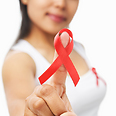
Israel sees alarming rise in HIV infections
Despite global drop in number of new HIV cases in past decades, 495 new infections reported in Jewish state in 2012, up 8% from 2011
These figures are particularly alarming as the global trend appears to be reversed.
According to data released recently by the UNAIDS organization, new HIV infections among adults and children were estimated at 2.3 million in 2012, a 33% reduction since 2001. New HIV infections among children have been reduced to 260,000 in 2012, a reduction of 52% since 2001.
26% of new cases diagnosed among women
A sharp rise was recorded in Israel in new cases among straight people and injecting drug users. The highest number of new cases was diagnosed in the MSM group (men who have sex with other men). The age group with the highest number of HIV-positive people is 31-40.
According to a report of the National Center for AIDS Confirmation Tests, the oldest person to test HIV positive was 92 years old. Twenty-six percent of the new cases were women, most of them aged 18 to 40, who are a majority of new infections among heterosexuals.
Last year also saw the birth of four babies infected with HIV, whose mothers did not receive medication to prevent the virus among their children. A number of additional cases of children born with HIV were discovered in 2013.
There are 35.3 million AIDS patients and HIV-positive people living around the world. The downward trend continued around the world in 2012, with 2.3 million new HIV-positive cases diagnosed in 2012, while 2.5 million were diagnosed in 2011.
Although HIV-positive people today can live to an almost average age in the Western world, in many places in the world HIV-positive people do not receive medication and become AIDS patients as a result.
Some 1.6 million AIDS-related deaths were recorded in 2012, down from 1.7 million the previous year.
Making treatment accessible
According to the UNAIDS report, by the end of 2012 some 9.7 million people in low- and middle-income countries were accessing antiretroviral therapy, an increase of nearly 20% in just one year.
The UNAIDS organization's target is to make the treatment accessible to 15 million people by 2015 and to reduce the cases of infection as a result of unprotected sex by 50%.
"The rise in the number of new cases is alarming, and it's unfortunate to see that hundreds of men, women and children have been infected and will be forced to receive regular medication for many years, till the end of their lives," says Dr. Yuval Livnat, director of Israel's AIDS Task Force.
"The UNAIDS report shows that in places with institutionalized investment in stopping the virus from spreading, there has been success.
"We call on the Health Ministry to increase its involvement in preventing the virus from spreading, while calling on people to use a condom when having sex with new partners and take periodical HIV tests at the HMOs and centers licensed by the Health Ministry across the country."










